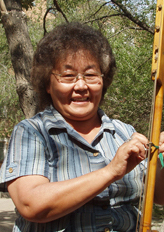Tuvan throat singing as intangible cultural heritage and as Tuva’s cultural brand
DOI:
https://doi.org/10.25178/nit.2019.2.6Keywords:
cultural heritage; intangible heritage; throat singing; Khѳѳmei; Tuvan music; Tuvan throat singing; UNESCO; cultural brand; Tuva; Tuvans; international cooperationAbstract
The article deals with the issues of preserving the unique Tuvan throat singing tradition, Khѳѳmei, which is seen as part of Tuva’s intangible cultural heritage. Correspondingly, our article is based on the UN recommendations on how to deal with challenges to this type of heritage.
There is a lot of information, including research, on Khѳѳmei available now. It has been collected primarily by two state institutions of Tuva whose task is to study and develop the throat singing tradition – Khѳѳmei International Research Center and the Center for Developing Traditional Tuvan Culture and Crafts. Although a number of publications have come out, there is still no dedicated catalogue of works on Khѳѳmei, nor of Khѳѳmei singers. Another set of challenges yet unmatched is to collect audio and video recordings of Khѳѳmei performances and provide access to it to all those interested. So far it has been in the hands of enthusiasts, including Khѳѳmei aficionados from outside Russia.
A most important task to preserve the authentic, true form of Khѳѳmei as intangible heritage is augmented by the fact that orally transmitted traditions are by nature “nimble” and changeable. The art of Khѳѳmei now exists both in its original form and – transformed – within contemporary musical forms where it is fused with various genres of pop, jazz, rock and avant-garde music. It has also entered the domain of what now is known as “world music”. This success has had an impact on Tuva’s international cultural ties and on the rise of ethnocultural tourism, and thus Khѳѳmei may and should be seen as a brand of contemporary Tuvan culture, as well as a factor of ethnic mobilization.
In 2011, the job of a throat singer has been officially recognized in Russia, and Khѳѳmeizhi now can enjoy the right for job benefits. This can be seen as an organizational victory. However, Khѳѳmei itself, as every form of art, needs legal protection. There is a global trend to see it as analogous to the so-called European mechanism of sound production (two-voice texture). Although Khѳѳmei can be entered on national and global registers as an asset of Tuvan ethnic culture, it is much more important to accept the correct methodology of teaching Khѳѳmei to students at educational institutions of art.
Future progress of Khѳѳmei also requires international cooperation in the fields of both research and practice.
References
Abildsnes, M. (2017) Tuvinskaia muzyka i ee diskografiia (osnovnye imena, nazvaniia, problemy opisaniia) [Tuvan music and its discography (principal names, titles, issues of description)]. The New Research of Tuva, no. 2 [online] Available at: https://nit.tuva.asia/nit/article/view/706 (access date: 01/02/2019). DOI: 10.25178/nit.2017.2.6
Gosudarstvennyi gimn Respubliki Tyva [National anthem of the Republic of Tuva]. Ofitsial'nyi portal Respubliki Tyva [online] Available at: http://gov.tuva.ru/region/gimn/ (access date: 15.01.2019).
Dmitriev, L. B., Chernov, B. P. and Maslov, V. T. (1992) Taina tuvinskogo «dueta» ili svoistvo gortani cheloveka formirovat' mekhanizm aerodinamicheskogo svista [The Mystery of the Tuvan "duo", or the property of the human larynx to form the mechanism of aerodynamic whistling]. Novosibirsk, s. n. 88 p.
Zhiteli Tuvy v dni prazdnovaniia 90-letiia TNR uslyshat novyi gosudarstvennyi gimn [Residents of Tuva during the celebration of the 90th anniversary of the TNR will hear the new national anthem] (2011). Komsomol'skaia pravda — Krasnoiarsk, 12 August [online] Available at: https://www.krsk.kp.ru/daily/25734/2724527/ (access date: 15.01.2019).
Kyrgys, Z. K. (1992a) Pesennaia kul'tura tuvinskogo naroda [The song culture of the Tuvan people] / ed. by I. V. Matsievskii. Kyzyl, Tuvan book publ. 143 p.
Kyrgys, Z. K. (1992b) Tyva chonnun ertinezi khѳѳmei [Khѳѳmei, the pearl of Tuva]. Kyzyl, MP «Novosti Tuvy». 128 p.
Kyrgys, Z. K. (2002) Tuvinskoe gorlovoe penie [Tuvan throat singing]. Novosibirsk, Nauka. 234 p.
Kyrgys, Z. K. (2007) Gorlovoe penie kak tselostnoe iavlenie traditsionnoi muzykal'noi kul'tury tuvintsev [Throat singing as an integral phenomenon of traditional musical culture of Tuvans]: Thesis of Dis. ... Doctor of Arts. Novosibirsk. 44 p.
Kyrgys, Z. K. (2013) Taina tuvinskogo gorlovogo peniia [The mystery of Tuvan throat singing]. Kyzyl, OAO «Tyvapoligraf». 128 p.
Levin, T. K. (2012) Muzyka novykh nomadov : gorlovoe penie v Tuve i za ee predelami [Music of new nomads: throat singing in Tuva and beyond] / with V. Yu. Suzukei; transl. from Engl. by I. Kun. Moscow, Klassika-XXI. 332 p.
Materialy I Mezhdunarodnogo simpoziuma «Khѳѳmei — kul'turnyi fenomen narodov Tsentral'noi Azii» [Proceedings of the 1st International Symposium "Khѳѳmei, a cultural phenomenon of the peoples of Central Asia"] (1992). Kyzyl, Tipografiia Goskomiteta po pechati i informatsii. 112 p.
Melodii «Khѳѳmeia» [Melodies of the Khѳѳmei] (1994): Proceedings and materials of an International Symposium. Kyzyl, 19–23 June 1992 / Ed. board: Iu. L. Aranchyn (ed.) et al. Kyzyl, Tuvan book publ. 110,[1] p.
Melodii Khѳѳmeia — III: Tezisy III Mezhdunarodnogo etnomuzykologicheskogo simpoziuma «Khѳѳmei — kul'turnyi fenomen narodov Tsentral'noi Azii» [Ringtones of Khѳѳmei — III: Abstracts of the III International Symposium ethnomusicological “Khѳѳmei — cultural phenomenon of the peoples of Central Asia”] (2003). Kyzyl, GUP Tyvapoligraf. 87 p.
Nauchnye doklady VII-go Mezhdunarodnogo simpoziuma «Khѳѳmei — kul'turnyi fenomen narodov Tsentral'noi Azii», 22–24 iiunia 2018 g. [Scientific reports at the VII International Symposium «Khѳѳmei — cultural phenomenon of the peoples of Central Asia”, 22–24 June, 2018] (2018). Kyzyl, OOO «Tyvapoligraf». 191 p.
O gosudarstvennykh nagradakh Respubliki Tyva (s izmeneniiami na 12 ianvaria 2018 goda) [On state awards of the Republic of Tuva (as amended on January 12, 2018)]. Elektronnyi Fond pravovoi i normativno-tekhnicheskoi dokumentatsii [online] Available at: http://docs.cntd.ru/document/802049211 (access date: 02.03.2019).
Prikaz Minzdravsotsrazvitiia RF ot 30.03.2011 N 251n Ob utverzhdenii Edinogo kvalifikatsionnogo spravochnika dolzhnostei rukovoditelei, spetsialistov i sluzhashchikh, razdel «Kvalifikatsionnye kharakteristiki dolzhnostei rabotnikov kul'tury, iskusstva i kinematografii» [Order of Ministry of health and social development of the Russian Federation of 30.03.2011 and N 251n About the approval of the Uniform qualification directory of positions of heads, experts and employees, section “Qualification characteristics of positions of workers of culture, art and cinematography”]. Zakony, kodeksy i normativno-pravovye akty Rossiiskoi Federatsii [online] Available at: http://legalacts.ru/doc/prikaz-minzdravsotsrazvitija-rf-ot-30032011-n-251n/ (access date: 02.03.2019).
Rekomendatsiia o sokhranenii fol'klora priniataia General'noi konferentsiei na ee dvadtsat' piatoi sessii (Parizh, 15 noiabria 1989 g.) [Recommendation on the preservation of folklore adopted by the General conference at its twenty-fifth session (Paris, 15 November 1989)] (2002). In: Normativnye akty IuNESKO po okhrane kul'turnogo naslediia (Konventsii, Protokoly, Rezoliutsii i Rekomendatsii) [UNESCO Regulations on the protection of cultural heritage (conventions, Protocols, Resolutions and Recommendations)]. Moscow, Publishing House Iuniprint. 225 p. Pp. 217–223.
Suzukei, V. Yu. (1993) Burdonno-obertonovaia osnova traditsionnogo instrumental'nogo muzitsirovaniia tuvintsev [Bourdonne-overtone basis of traditional instrumental music of Tuva]. Kyzyl, Tuvan book publ. 92 p.
Suzukei, V. Iu. (2001) Khѳѳmei v kontekste sovremennosti [Khѳѳmei in the context of modernity]. In: Gumanitarnye issledovaniia v Tuve [Humanitarian researches in Tuva] : collection of scientific works. Moscow, Izdatel'stvo Rossiiskogo universiteta druzhby narodov. 334 p. Pp. 313–318.
Suzukei, V. Yu. (2006) Kul'turno-istoricheskie korni muzykal'nogo naslediia tuvintsev, ego funktsionirovanie i modernizatsiia v XX veke [Cultural and historical roots of the musical heritage of Tuva, its functioning and modernization in the twentieth century]: Diss. … Doctor of Culturology. Kyzyl. 331 p.
Suzukei, V. Yu. (2007) Muzykal'naia kul'tura Tuvy v XX stoletii [The Musical culture of Tuva in the twentieth century]. Moscow, Publishing House Kompozitor. 408 p.
Tatarintsev, B. I. (1998) Tuvinskoe gorlovoe penie. Problemy proiskhozhdeniia [Tuvan throat singing: problems of origin]. Kyzyl, MNTs «Khѳѳmei». 78 p.
Tezisy nauchnykh dokladov V Mezhdunarodnogo simpoziuma «Khѳѳmei is kul'turnyi fenomen narodov Tsentral'noi Azii», 25–27 iiulia 2008 g. [Abstracts of papers given at the 5th International Symposium “Khѳѳmei, a cultural phenomenon of the peoples of Central Asia”, 25–27 July 2008] (2008). Kyzyl, GUP Tyvapoligraf. 184 p.
Tezisy IV-go Mezhdunarodnogo etnomuzykologicheskogo simpoziuma «Khѳѳmei — kul'turnyi fenomen narodov Tsentral'noi Azii» (25–28 iiunia 2003 g.) [Abstracts of papers presented at the 4th International Symposium “Khѳѳmei, a cultural phenomenon of the peoples of Central Asia” (25–28 June 2003)] (2003). Kyzyl, s. n. 50 p.
Ustav gosudarstvennogo biudzhetnogo uchrezhdeniia «Mezhdunarodnyi nauchnyi tsentr “Khѳѳmei”» [Charter of the state budgetary institution “The International scientific center “Khѳѳmei””]. Mezhdunarodnyi nauchnyi tsentr «Khѳѳmei» [online] Available at: http://www.khoomey.ru/wp-content/uploads/2016/10/ Ustav_MNTs_Khѳѳmei.pdf (access date: 02.03.2019).
Khѳѳmeizhi Respubliki Tyva [Khѳѳmeizhi of the Republic of Tuva] (2015) / comp. by V. Yu. Suzukei and Ch. S. Tumat. Kyzyl, Tipografiia OOO «Zhurnalist». 192 p.
Mongolian traditional art of Khöömei [Mongolian traditional art of Khѳѳmei]. UNESCO [online] Available at: https://ich.unesco.org/en/RL/mongolian-traditional-art-of-khoomei-00396 (access date: 02.03.2019).
Published
How to Cite
Lamazhaa Ch. K. and Susukey V. Yu. Tuvan throat singing as intangible cultural heritage and as Tuva’s cultural brand. The New Research of Tuva. 2019, № 2 [online] Available at: https://nit.tuva.asia/nit/article/view/846 (access date ...). DOI: 10.25178/nit.2019.2.6
Issue
Section

Author(s) license holder(s) grant rights for their work to the journal (grantee of a license) under the simple non-exclusive open license in accordance with Art. 1286.1 «Open license for a research work, work of literature or fine arts», Civil Code of the Russian Federation.
New Research of Tuva publishes articles under the Creative Commons Attribution-NonCommercial license (CC BY-NC).
Since it is an open license, author(s) reserve the right to upload the article to their institutional repository, submit it to another journal (if it allows republications), or republish it on their own website (in full, or in part).
However, several conditions apply here:
a) The republished version must always contain the name(s) and affiliation(s) of the author(s), the original title and the hyperlink to the original version on the New Research of Tuva website;
b) It must be in open access, free of charge, and no category of readers must be in any way whatsoever advantaged over general readership.
c) should the contribution be submitted elsewhere by its author(s) without substantial modification (30% or more of original text unchanged), the body of the article should contain a disclaimer that the original version was published in New Research of Tuva (with a link to the respective page)
The CC-BY-NC is a non-revocable license which applies worldwide and lasts for the duration of the work’s copyright.










